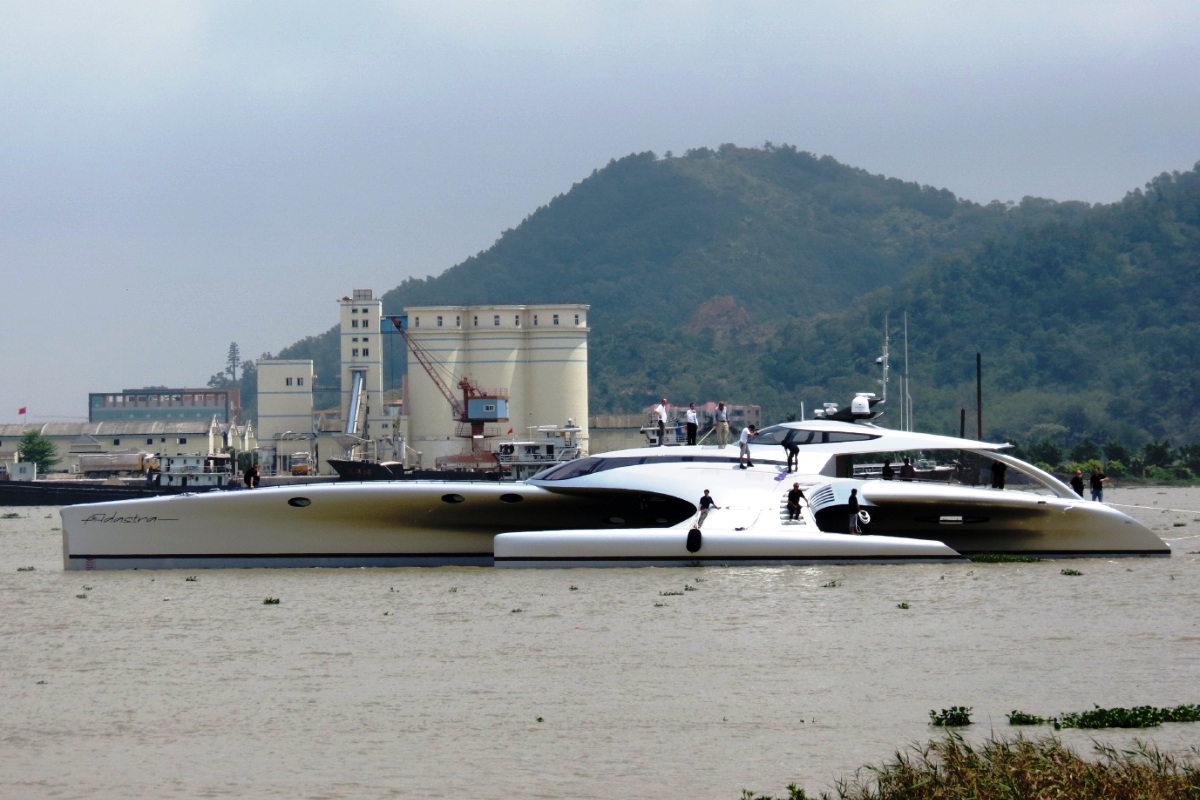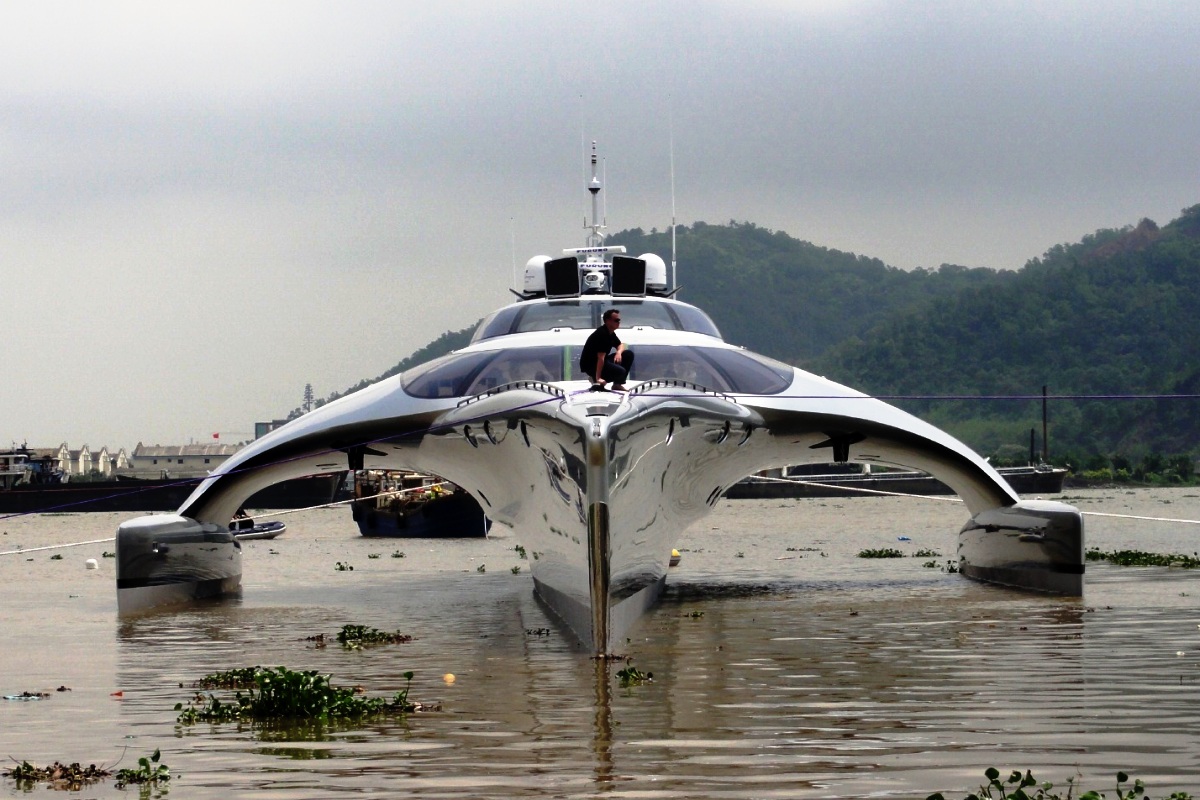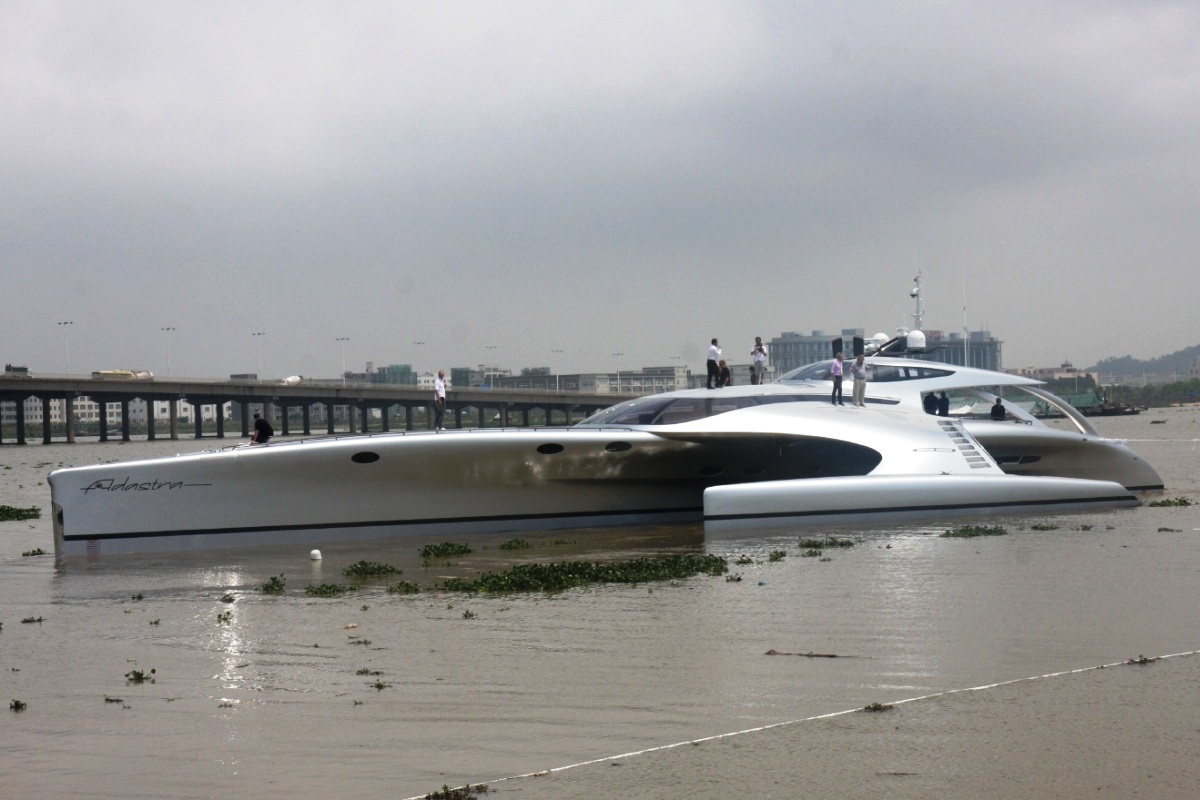Adastra Yacht Trimaran (Four)
Friday, May 4, 2012 |
| Adastra Yacht Trimaran 4 | OceanShooter – Ship and Boat. |
| image resolutions : 1200 x 800 |
Adastra Yacht Trimaran (Four) Adastra, Yacht, Trimaran, John Shuttleworth, luxury, McConaghy, Anto Marden, boat, ship, ocean, voyage, widescreen, wallpaper, photo, picture.
With her shiny body and smooth curves, this £15-million superyacht is a real wealth symbol. The Adastra, unveiled today in China, is the new floating pleasure palace of billionaire businessman Anto Marden who commissioned its construction five years ago. Designed by Sussex-based yacht designer John Shuttleworth, Adastra Yacht Trimaran 4 is so high-tech, it can even be cotrolled remotely at the touch of an iPad... as long as you don't get any further away than 50 metres. Marden, who is based in Hong Kong and made his fortune in the shipping industry, will be able to sail the state-of-the-art boat between the two islands he already owns off the coast of Indonesia. Described as ‘one of the world's most amazing super yachts’, Adastra is 42.5 metres long, 16 metres wide and weighs 52 tons. ‘It takes the power trimaran concept further than has ever been attempted before,’ Mr Shuttleworth told Boat International. ‘The challenge of turning this concept into a viable luxury yacht has taken us to further research and to develop new thinking on stability and comfort at sea for this type of craft.’ It is the result of five years of planning and construction, and rivals anything owned by yacht-lover Roman Abramovich. The hull of the Adastra is built from glass and Kevlar and can house nine guests and six crewmen. The deck saloon has a panoramic view while the open cockpit has sofas on both sides. The open deck running aft also has a door that hinges out to create a bathing platform. Maximum speed reached by the yacht is 22.5 knots and her range is an astonishing 4000 nautical miles at 17 knots. That is enough for a trip from the UK to New York. Boat International magazine said Adastra Yacht Trimaran 4 'could spell the future for efficient long range cruising'. The yacht has an integrated ship monitoring system, and can even be controlled with an Apple iPad within a 50-metre range. Adastra is powered by one Caterpillar C18 engine of 1150hp at 2300 rpm and has 2 Yanmar 110hp @ 3200 rpm outrigger engines. Adastra's 16-metre beam features a saloon area on the main deck with a lounge area, dining table, and navigation station. The deck at the rear of the yacht has a sofa and bar area to port and a dining area to starboard. The main helm station, which has seating for two, is positioned in a raised pilot house situated between the rear deck and the saloon area and forms part of the cross beam structure. The Adastra is the latest in a long line of super yachts that compete to be the most high tech. Last year Chelsea Football Club owner Roman Abramovich bought a £300 million superyacht with two swimming pools, two helipads, a gym, hair salon, dancefloor and submarine. Eclipse has plenty of room to entertain friends, with 15 double bedroom cabins all equipped with their own luxury bathrooms and 6ft wide television screens. Parties on the 533ft yacht are guaranteed to stay private, as it’s fitted with an ‘anti-paparazzi shield’ that fires a laser beam of light at cameras to ruin photographs. The 20,000 sq ft interior also houses a sauna, steam bath and whirlpool to help guests wind down. For more than 40 years McConaghy has been at the cutting edge of race yacht construction; leading the way in research and application of new materials and technologies to build some of the strongest, lightest Ð and most successful Ð racing yachts ever launched. But that is only part the McConaghy success story. With manufacturing basis in both Australia and China, McConaghy now deploys its wealth of talent and its mastery of laminated construction techniques across a number of different divisions, extending the strong commercial platform that has allowed it to defy industry trends and continue to thrive. Adastra Yacht Trimaran 4
With her shiny body and smooth curves, this £15-million superyacht is a real wealth symbol. The Adastra, unveiled today in China, is the new floating pleasure palace of billionaire businessman Anto Marden who commissioned its construction five years ago. Designed by Sussex-based yacht designer John Shuttleworth, Adastra Yacht Trimaran 4 is so high-tech, it can even be cotrolled remotely at the touch of an iPad... as long as you don't get any further away than 50 metres. Marden, who is based in Hong Kong and made his fortune in the shipping industry, will be able to sail the state-of-the-art boat between the two islands he already owns off the coast of Indonesia. Described as ‘one of the world's most amazing super yachts’, Adastra is 42.5 metres long, 16 metres wide and weighs 52 tons. ‘It takes the power trimaran concept further than has ever been attempted before,’ Mr Shuttleworth told Boat International. ‘The challenge of turning this concept into a viable luxury yacht has taken us to further research and to develop new thinking on stability and comfort at sea for this type of craft.’ It is the result of five years of planning and construction, and rivals anything owned by yacht-lover Roman Abramovich. The hull of the Adastra is built from glass and Kevlar and can house nine guests and six crewmen. The deck saloon has a panoramic view while the open cockpit has sofas on both sides. The open deck running aft also has a door that hinges out to create a bathing platform. Maximum speed reached by the yacht is 22.5 knots and her range is an astonishing 4000 nautical miles at 17 knots. That is enough for a trip from the UK to New York. Boat International magazine said Adastra Yacht Trimaran 4 'could spell the future for efficient long range cruising'. The yacht has an integrated ship monitoring system, and can even be controlled with an Apple iPad within a 50-metre range. Adastra is powered by one Caterpillar C18 engine of 1150hp at 2300 rpm and has 2 Yanmar 110hp @ 3200 rpm outrigger engines. Adastra's 16-metre beam features a saloon area on the main deck with a lounge area, dining table, and navigation station. The deck at the rear of the yacht has a sofa and bar area to port and a dining area to starboard. The main helm station, which has seating for two, is positioned in a raised pilot house situated between the rear deck and the saloon area and forms part of the cross beam structure. The Adastra is the latest in a long line of super yachts that compete to be the most high tech. Last year Chelsea Football Club owner Roman Abramovich bought a £300 million superyacht with two swimming pools, two helipads, a gym, hair salon, dancefloor and submarine. Eclipse has plenty of room to entertain friends, with 15 double bedroom cabins all equipped with their own luxury bathrooms and 6ft wide television screens. Parties on the 533ft yacht are guaranteed to stay private, as it’s fitted with an ‘anti-paparazzi shield’ that fires a laser beam of light at cameras to ruin photographs. The 20,000 sq ft interior also houses a sauna, steam bath and whirlpool to help guests wind down. For more than 40 years McConaghy has been at the cutting edge of race yacht construction; leading the way in research and application of new materials and technologies to build some of the strongest, lightest Ð and most successful Ð racing yachts ever launched. But that is only part the McConaghy success story. With manufacturing basis in both Australia and China, McConaghy now deploys its wealth of talent and its mastery of laminated construction techniques across a number of different divisions, extending the strong commercial platform that has allowed it to defy industry trends and continue to thrive. Adastra Yacht Trimaran 4
- Adastra Yacht Trimaran (Wallpaper 1)
- Adastra Yacht Trimaran (Wallpaper 2)
- Adastra Yacht Trimaran (Wallpaper 3)
Labels: Adastra


















